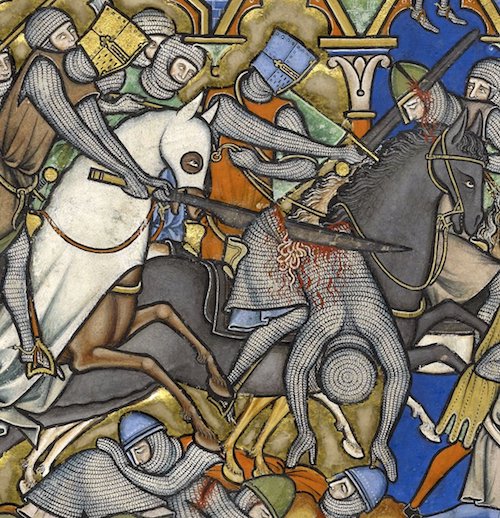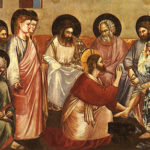We run our website the way we wished the whole internet worked: we provide high quality original content with no ads. We are funded solely by your direct support. Please consider supporting this project.

The Violent “Church Triumphant”
In light of how central enemy-loving non-violence is to Jesus’ teaching and to his cross-centered revelation of God, we have to wonder why the church has refused to listen to its head and instead condoned violence, as pointed out in the previous post? Christian theologians have used OT’s violent portraits of God, at least since fourth century to promote the use of violence. For example, how could Luther have failed to wrestle with the violent portraits of the Old Testament when he claimed to “see nothing in Scripture except Christ crucified”?
For the first three centuries of church history, theologians such as Origen found non-literal ways of interpreting the OT’s violent divine portraits so that they could not be used to promote violence. Christians during this period took seriously Jesus’ call to refrain from violence and to love and serve enemies. However beginning in the early fourth century, the church began to undergo a massive transformation.
It began when a Roman emperor named Constantine allegedly had a vision just before a major battle he was going to fight. This vision convinced him that he and his army would defeat their foes if he fought under the banner of Christ. This was the first (but unfortunately hardly the last) time the name of Jesus Christ was associated with violence. Constantine won the battle, and since pagans have always assumed that military victories reveal which army has the stronger god, Constantine decided to pledge his allegiance to Christ. However, his version of Christ was a triumphant pagan warrior deity rather than as the self-sacrificial loving Savior.
Constantine legalized Christianity in 313 A.D. and he showered the Church with wealth and political power. In the span of less than a century, the Church went from being a despised and persecuted minority within the Roman Empire to the official religion of the Roman Empire, making it illegal for everyone except Jews not to be a Christian. And since the religion of Rome had always played an important role in the running of the State, the Church began to play this role.
However, it’s impossible to play any role in running the Roman Empire (or any other empire for that matter) if you’re not willing to use the sword to preserve law and order and to protect the State from threatening foes. So, not surprisingly, in the fourth and fifth centuries we find Christian theologians like St. Augustine going to extreme lengths to try to justify the use of violence, despite the NT’s clear teachings to the contrary.
Whereas the persecuted Church of the first three centuries believed it was called to refrain from violence and serve the world by carrying the cross, the politically-empowered Church of the fourth and fifth centuries began to believe it was called to conquer the world for Christ, wielding the sword when necessary. The persecuted Church became the persecuting “Church Triumphant,” since it now had the political authority to persecute heretics and unbelievers. The Empire of Rome was retitled “the holy Roman Empire,” and Christ was believed to be its triumphant Emperor. “Christendom” was born, and while this religion has (thankfully) been dying for the last several hundred years, it has, for all intents and purposes, been the face of Christianity for the last fifteen hundred years.
As Christendom was coming into being, and Christians acclimated to the use of violence, the OT’s violent depictions of God became much less problematic. Indeed, it became advantageous at this time to interpret these portraits literally. Christendom’s leaders could appeal to them when they needed to justify their use of violence and when they needed to motivate Christians to engage in violence on behalf of their “Christian” Empire. Tragically, these violent portraits have been serving this function ever since.
Image: Fatality, ‘Maciejowski Bible’, Paris ca. 1240 (NY, Morgan Library & Museum, MS M.638, fol. 10v)
Category: General
Tags: Augustine, Constantine, Cruciform Theology, Jesus, Violence
Topics: Enemy-Loving Non-Violence, The Church
Related Reading

Dear Greg: My Spouse Thinks Spanking is Okay and I Do Not (podcast)
Greg offers thoughts on how spanking plants a seed of redemptive violence and offers ideas for resolving differences of opinion between spouses. Episode 507 http://traffic.libsyn.com/askgregboyd/Episode_0507.mp3

Living Incarnationally
The Christian faith is centered on the belief that in Jesus Christ God became a human being. This is commonly referred to as the doctrine of the incarnation. It means that in Jesus, God became embodied. God left the blessed domain of heaven, was born in Bethlehem, and took on our humanity that we might…

Crucified Transcendence
If our thinking about God is to be faithful to the New Testament, then all of our thinking about God must, from beginning to end, be centered on Christ. I’m persuaded that even our thinking about God in his transcendent, eternal state should begin and proceed with the Pauline conviction that we know nothing “except…

The “Christus Victor” View of the Atonement
God accomplished many things by having his Son become incarnate and die on Calvary. Through Christ God revealed the definitive truth about himself (Rom 5:8, cf. Jn 14:7-10); reconciled all things, including humans, to himself (2 Cor 5:18-19; Col 1:20-22), forgave us our sins (Ac 13:38; Eph 1:7); healed us from our sin-diseased nature (1…


